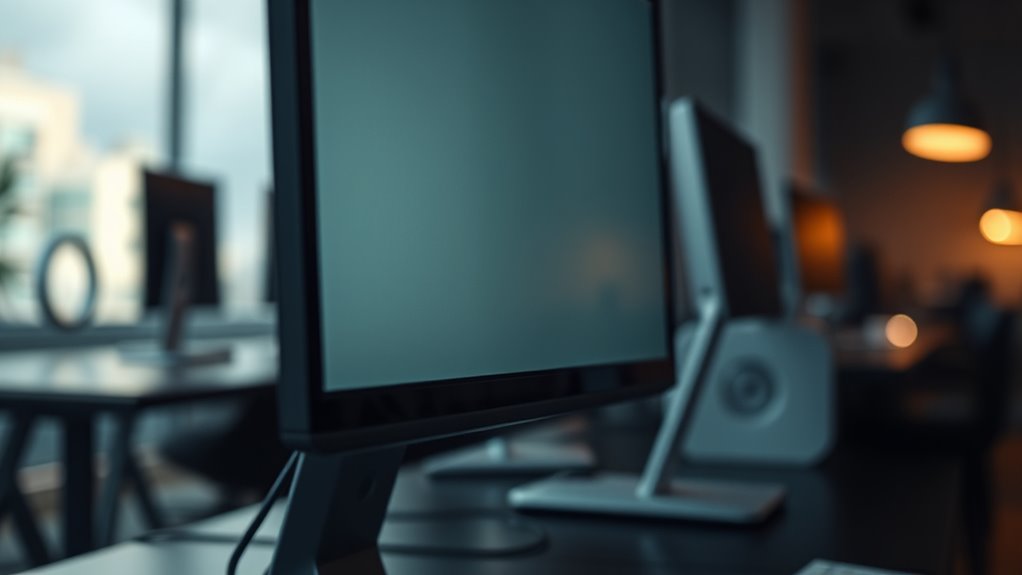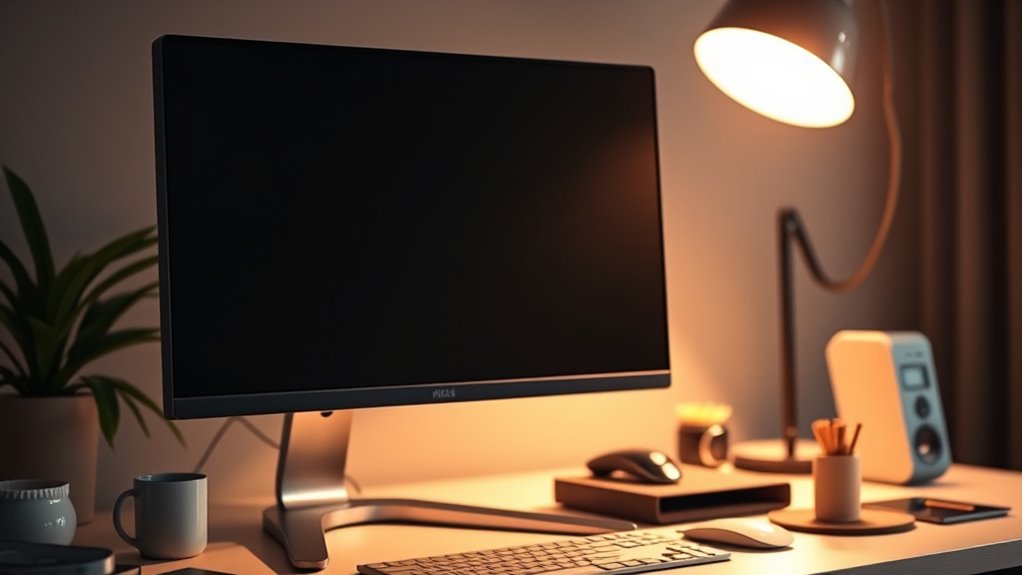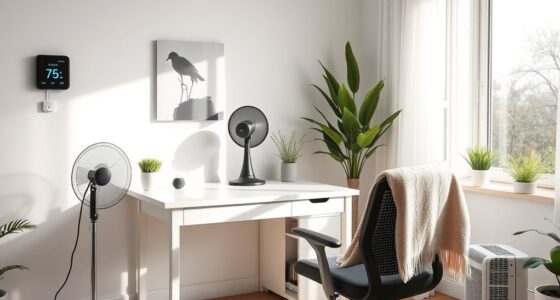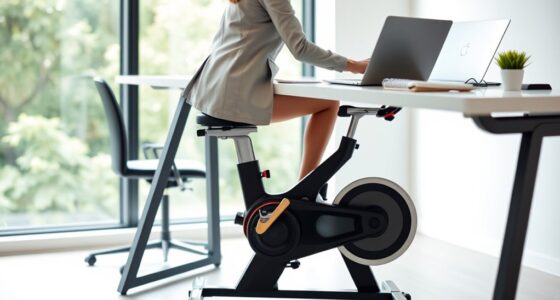To avoid eye strain, you should adjust your monitor’s brightness to match your surrounding lighting—neither too bright nor too dim. Set your contrast to ensure text and images appear crisp and easy to distinguish. When your screen’s brightness aligns with ambient light, your eyes won’t have to work as hard. Take these steps, and you’ll notice less fatigue. Keep exploring to discover more tips for comfortable, eye-friendly workstation setups.
Key Takeaways
- Adjust monitor brightness to match ambient lighting to reduce eye fatigue.
- Set contrast for clear, sharp images and easily distinguishable text.
- Use automatic or manual brightness settings rather than relying solely on auto-adjust features.
- Avoid overly bright screens in dim environments to prevent strain and discomfort.
- Regularly calibrate your monitor to maintain optimal brightness and contrast levels.

In today’s digital age, spending long hours in front of screens can easily lead to eye strain. To protect your vision, it’s essential to optimize your monitor brightness and contrast, but there’s more to it. Creating an ergonomic workspace is a crucial step that can significantly reduce eye discomfort. A well-designed setup means your monitor should be positioned at eye level, about an arm’s length away, with proper lighting around you. This helps minimize the strain on your eyes and neck by encouraging a natural, comfortable posture.
Creating an ergonomic workspace reduces eye and neck strain for comfortable screen use.
One effective way to lessen eye fatigue is by implementing blue light reduction techniques. Blue light emitted by screens can cause eye strain and disrupt sleep patterns, especially when you work late into the night. Using blue light filters or glasses can cut down the amount of this high-energy light reaching your eyes. Many monitors come with built-in blue light reduction settings, which you can activate to make viewing easier and more comfortable. Alternatively, installing software or using apps that adjust the screen’s color temperature during evening hours can help. These tools reduce the harshness of blue light, easing the burden on your eyes without sacrificing screen clarity.
Adjusting your monitor’s brightness and contrast is another vital step. If your screen is too bright compared to your surroundings, your eyes work harder to focus, causing fatigue. Conversely, a dim screen can make details hard to see, forcing you to squint and strain. Aim for a balance where the brightness matches ambient lighting, and contrast levels are set so that texts and images are crisp and easy to distinguish. Many monitors have automatic brightness settings that adapt to your environment, but manual adjustments often deliver better results for prolonged use. Additionally, understanding contrast ratio can help you optimize image quality and reduce eye strain during extended viewing sessions.
Your workspace setup plays a big role in preventing eye strain. Keep your monitor free from glare by positioning it perpendicular to windows or light sources. Use curtains or blinds if necessary, and consider matte screens to reduce reflections. Proper ergonomic positioning means your eyes should gaze slightly downward at the screen, avoiding the need to tilt your head or squint. This minimizes tension around your neck, shoulders, and eyes. Remember, frequent breaks are just as important—every 20 minutes, look away for at least 20 seconds to give your eyes a rest.
Frequently Asked Questions
How Does Ambient Lighting Affect Monitor Brightness Settings?
Ambient light substantially impacts your monitor brightness settings because it influences how you perceive the screen. When there’s strong ambient light, you might need to increase brightness to prevent your display from appearing dim. Conversely, in low-light environments, lowering brightness helps reduce glare and eye strain. Adjusting contrast accordingly ensures clear visibility and glare reduction, making your viewing more comfortable. Always match your monitor’s brightness to ambient light for ideal comfort and minimal eye fatigue.
Can Specific Colors Reduce Eye Strain More Effectively?
You might notice that certain colors can lessen eye strain, especially when you consider color temperature and calibration. Cooler tones, like soft blues, tend to relax your eyes, while warmer hues may cause fatigue over time. Proper color calibration guarantees these tones are accurate, reducing visual stress. When you choose monitor settings thoughtfully, you’re more likely to protect your eyes, making your screen time comfortable and less taxing.
Are There Recommended Monitor Settings for People With Sensitive Eyes?
If you have sensitive eyes, you should look for monitor settings that reduce blue light and feature flicker-free displays. Adjust brightness to match your room lighting—neither too bright nor too dim—and increase contrast for clarity. Many monitors have preset modes for eye comfort. These adjustments help minimize eye strain by reducing blue light exposure and flickering, making your viewing experience more comfortable and less tiring.
How Often Should I Adjust My Monitor’s Brightness and Contrast?
Ever wondered how often you should tweak your monitor for perfect eye comfort? The secret lies in regular monitor calibration—ideally daily or whenever lighting changes. Small adjustments help prevent eye strain and keep your display optimized. Don’t wait until discomfort hits; staying proactive guarantees your monitor’s brightness and contrast stay aligned with your environment, preserving your eye health and comfort. Keep calibrating, and enjoy seamless viewing every time.
Do Screen Filters or Glasses Help Reduce Eye Strain?
Screen filters and glasses can definitely help reduce eye strain. Using screen filters that block blue light minimizes eye fatigue, especially during long screen sessions. Blue light glasses further cut down glare and blue light exposure, making it easier for you to focus comfortably. Combining these tools with proper monitor adjustments creates a more eye-friendly environment, helping you stay comfortable and reduce strain during extended computer use.
Conclusion
To prevent eye strain, prioritize perfect picture settings by balancing brightness and contrast. Brighten your boundary when bright, and dim your display when dull. Don’t forget to take frequent, friendly breaks to foster focus and fend off fatigue. Fine-tune your monitor for comfort, creating a clear, calming contrast that keeps your eyes engaged without exhaustion. With mindful modifications, you’ll master your monitor’s metrics, making your screen a source of satisfaction, not strain.









